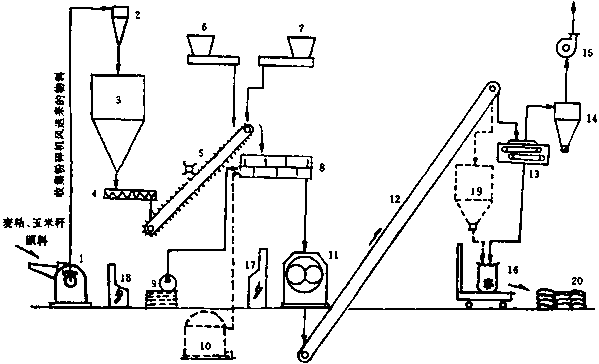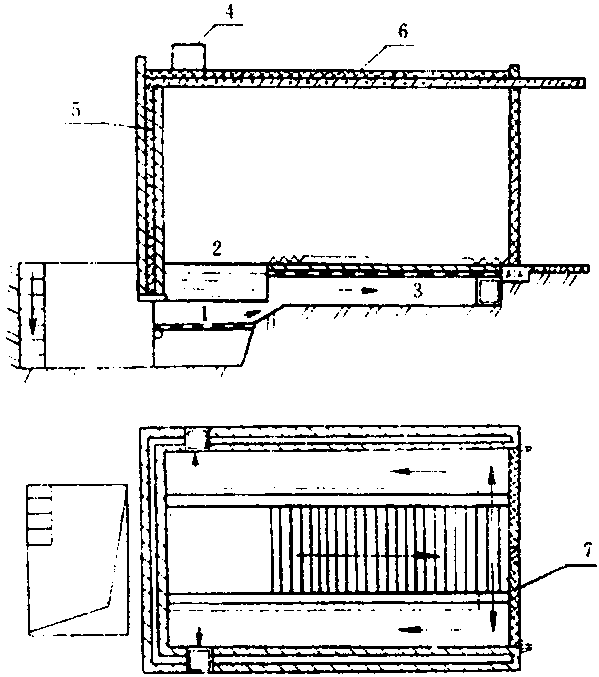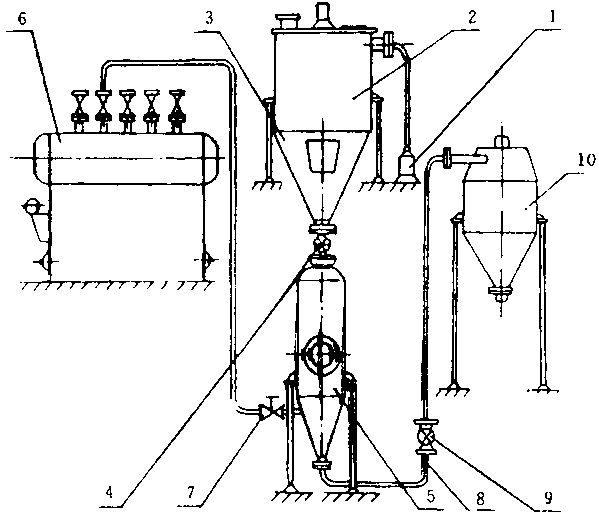The ammoniation reaction occurs at temperatures above 0°C. Reaction speed increases with temperature. There are many methods for ammoniation under normal temperature, such as stack ammoniation and use of an ammonia silo. Straw ammoniation can be carried out using various sealable containers.
The sources of ammonia for straw treatment are anhydrous ammonia, aqueous ammonia, ammonium bicarbonate and urea. When using aqueous ammonia, ammonium bicarbonate or urea, water should be added at a prescribed rate. Straw uniformly mixed with the ammonia source is sealed in the container for the ammoniation. Anhydrous ammonia is kept as a liquid under high pressure and therefore pressure containers are required to transport and store it. A minimum set of equipment, including perforated metal pipe (ammonia injection spear), volume meter, ammonia pressure meter and some safety equipment, are required for ammonia injection. Because anhydrous ammonia is a potentially dangerous and toxic material, stringent safety measures need to be taken.
Figure 6-25. Flow chart of 93KCT-1000 complete roughage wafering set operation

KEY: 1. Grinder; 2. Cyclone; 3. Buffering bin; 4. Double-screw conveyor; 5. Rationing conveyor; 6. Chemical additive dosing mechanism; 7. Concentrate adding mechanism; 8. Mixer; 9. Water adding mechanism; 10. Heat source for cooking; 11. Waferer for coarse silage; 12. Tilt conveyor; 13. Horizontal cooler; 14. Cyclone; 15. Fan; 16. Packing machine; 17. Electronic control console; 18. Grinder control console; 19. Final product bin; 20. Product.
To the north of the Yellow River, the temperature is usually below 0°C in winter, and thus the ammoniation reaction can not happen. In order to deal with this problem, some new ways for ammoniation were developed in these areas.
Heated ammoniation-bunker method
The traditional method for heating material using the smoke channels of a stove - a procedure widely used in rural areas to cultivate sweet potato seedlings in early spring - is used for straw ammoniation. It is called the heated ammoniation-bunker method. The structure of the bunker is shown in Figure 6-26. The operating steps are as follows: a bunker is constructed with brick and concrete, half underground. A stove is built at one end of the bunker, under which there are two smoke channels connected to a chimney at the other end of the stove. Firstly, the straw, mixed with the urea or ammonium bicarbonate solution at recommended doses, is placed into the bunker and sealed. Next, the straw inside the stove is ignited to heat the treated straw during half a day at a temperature of 30°C. The amount of straw burnt is equivalent to 5-10 percent. After a week, the treated straw can be fed. Longer heating times or higher temperature can shorten ammoniation time.
Figure 6-26. Ammoniation bunker for heating

KEY: 1. Stove; 2. Heat channel; 3. Chimney; 4. Plastic sheet
Ammoniation in tobacco curing houses
Tobacco curing houses are usually empty in winter. The straw is placed into the tobacco house, a urea or ammonium bicarbonate solution added, the straw well sealed, and then heated by burning coal. The house is kept at 40-50°C for 3-4 days for the ammoniation to be completed. This is a practical method in tobacco-growing areas.
Ammoniation in ovens
The ammoniation oven has proved to be an efficient item of equipment for livestock farms where straw ammoniation needs to be industrialized and delivered regularly according to a plan. Figure 6-27 outlines an oven with a straw trailer that can be pulled in and out. The source of ammonia can be anhydrous ammonia or ammonium bicarbonate. In Figure 6-27, anhydrous ammonia is used. Of course, anhydrous ammonia needs to be transported and stored in pressure containers. Urea is not suitable for oven ammoniation, with its temperature as high as 90°C, because the ureases required to break down urea are destroyed at these temperatures. There are three heating options: electricity, steam or coal. The oven may be a metal box or of brick construction. The parameters for a 30 m3 metal box-oven heated by electricity are listed in Table 6-5.
Figure 6-27. Oven for ammonia treatment of straw

KEY: 1. Oven; 2. Door; 3. Straw trolley; 4. Track; 5. Straw baler; 6. Ammonia bottle; 7. Perforated metal pipe for ammonia injection (ammonia spear).
When an electric element is used to heat the oven, the temperature and heating time can be automatically controlled using a thermostat and timer. This oven has the advantages of simple operation, time and labour saving and high level of automation. A 30 m3 oven can treat 1.5 tonne of straw within 24 hours. The energy consumed per tonne of straw is less than 100 kWh, with a cost of ¥ 29 (in 1990), equivalent to the daily wage of two persons.
Steam is a convenient source of heat on cattle farms equipped with steam sterilizers. Oven temperature depends on steam pressure and supply time. Generally, oven temperature is maintained with steam at 70°C for 10-12 hours, then the straw is kept in the oven for a further 22-24 hours. Considering only the coal used, the cost of steam is only 40 percent of electricity.
A built up oven, heated with coal and steam, is shown in Figure 6-28. Its walls, top and bottom are constructed with bricks, cement and insulating material. The straw trolley can be pulled in and out. At one end of the oven, a stove is built in a pit. The tank, situated above the stove, provides the water for steam generation. The hot air flows through the main channel (3) from one end to another, turns to the second channel, returns to the main channel again and is finally released via the chimney (4). The oven is equipped with a straw trolley, wheel tracks and hard rubber wheels. When hard rubber wheels are used, the straw trolley is easily moved for loading/unloading. Rails are used for guiding when loading and unloading.
Figure 6-28. Ammoniation oven heated by coal and steam

KEY: 1. Stove; 2. Water tank; 3. Smoke channel; 4. Chimney; 5. Insulation; 6. Insulated top; 7. Insulated door.
In coal producing areas such as Shanxi province, heat from coal is ten times cheaper than from electricity. It is a convenient fuel for regions with sufficient supplies and cheaper labour.
Heat-explosion equipment
The principles of heat-explosion combine heat reaction and mechanical processing. Under the action of steam at 170°C, straw lignin is broken down and partly hydrolyzed. During the explosion, the particles impact each other inside the tube and at the same time the water trapped within cells rapidly expands to a gaseous state and physically tears apart the brittle cell wall. Straw is shredded into fine particles, greatly increasing its surface area. The quality of the treated straw is considerably improved. Equipment and a flow chart of the technology is shown in Figure 6-29.
After cutting by the chopper (1), the material is transported via the storing bin (2), the hopper (3) and charging valve (4) to pressure container (5). After being sealed, the container (5) is injected with low or medium pressure steam to a pressure of 0.5-1.0 MPa, supplied by the burner (6) and controlled by the discharge valve (7), and maintained at this high pressure for some time (from 1 to 30 minutes). The pressure is then abruptly released through the rotating ball valve (9), and the material discharged into container (10) through tube (8), for subsequent direct feeding or pelleting.
The cost of this equipment was ¥ 65 000 in 1990. The volume of the pressure container is 0.9 m3. Straw output is 300 - 400 kg/hour, coal consumed is ca 50 kg/hour, and the cost for treating 1 kg of straw is about ¥ 0.02.
After heat-explosion, the physical properties of the straw have been changed, and the intake of the entire crop is increased by 50 to 90 percent. The digestibility is increased more than 50 percent. The heat explosion treatment can eliminate the toxins of colza (rapeseed) and cottonseed cakes, and sterilize the faeces of chicken, duck and cattle to odourless materials.
Figure 6-29. Heat-explosion equipment

KEY: 1. Chopper; 2. Storage bin; 3. Feed hopper; 4. Feed valve; 5. Pressure container; 6. Boiler; 7. Inlet steam valve; 8. Discharge tube; 9. Discharge valve; 10. Storage container.